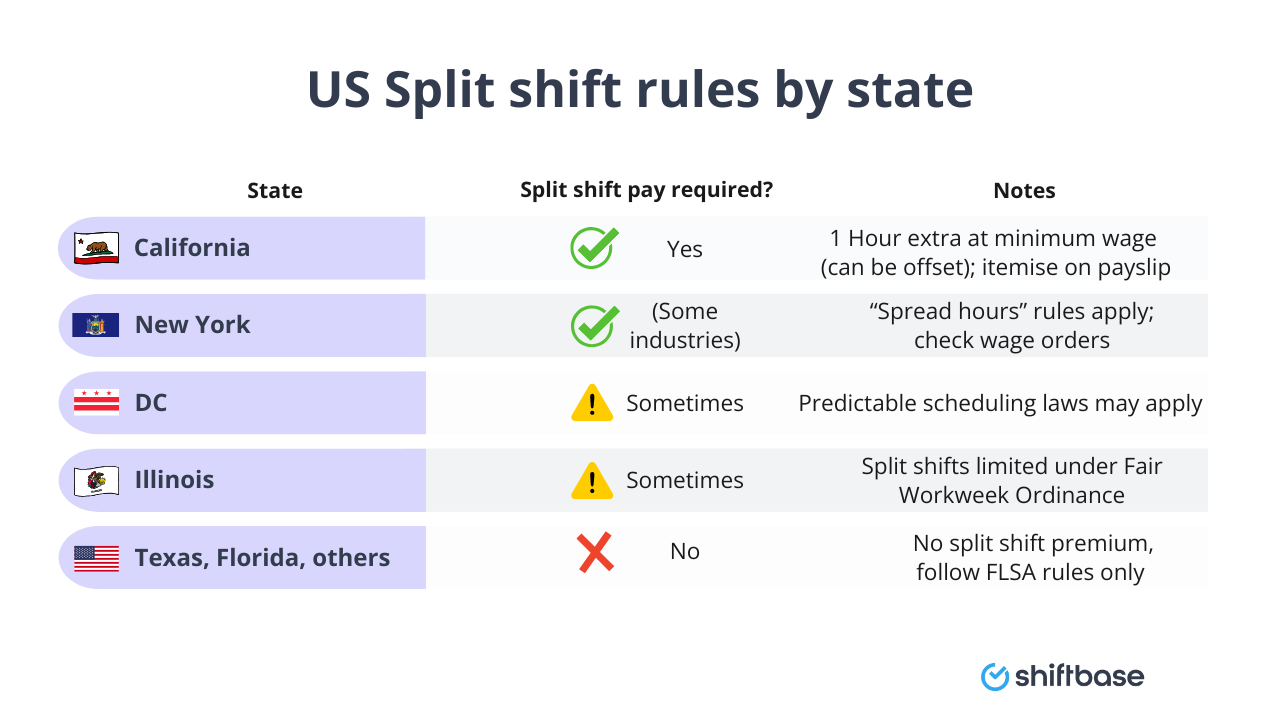This article delves into how split shifts work, their benefits, limitations, and how they can impact various aspects of your business.
What is a split shift?
Split shifts are workdays that are… well, split in two (or more) parts.
Instead of working one long, continuous shift (like 9 to 5), an employee might work from 7:00 to 11:00 in the morning, take a few hours off, and then return to work again from 15:00 to 19:00. The gap in the middle is unpaid and usually not counted as a break; it’s proper time away from the job.
This setup is common in industries with peaks in demand, like:
-
Hospitality – busy breakfast and dinner service, quieter mid-afternoon.
-
Retail – shops needing coverage during opening and closing hours.
-
Healthcare and social care – patients or residents needing support early and late, but not midday.
-
Transport – school bus drivers or delivery workers with morning and afternoon rounds.
For employers, split shifts can be a handy way to match staffing to actual business needs. But they’re not always popular with employees (more on that below), so they need to be handled carefully.
A quick example
| Time |
What’s happening |
Paid? |
| 07:00 – 11:00 |
First work period |
✅ Yes |
| 11:00 – 15:00 |
Off-duty (not on break) |
❌ No |
| 15:00 – 19:00 |
Second work period |
✅ Yes |
⚠️ Important: That 4-hour gap is not a paid break. It’s unpaid time where the employee is off the clock and not at your disposal.
UK legal rules for split shifts
Split shifts are allowed in the UK, but they come with a few important conditions. If you’re using them (or thinking about it) here’s what you need to know to stay on the right side of the law and keep your team happy.
Working Time Regulations still apply (mostly)
The Working Time Regulations 1998 (WTR) say workers should get:
-
At least 11 hours rest between working days
-
A 20-minute break if working more than 6 hours
-
No more than 48 hours a week (unless they’ve opted out)
With split shifts, things get a little flexible. If the total working time per day is spread across a longer day (say 7:00–11:00 and 15:00–19:00), the break between those two shifts doesn’t count toward rest time; it’s unpaid time off. But you still need to:
-
Track the total hours worked
-
Make sure they’re not going over limits
-
Avoid scheduling shifts too close together (e.g. finishing at 22:00 and restarting at 6:00 is a no-no)
New in 2025: Short-notice shift protections
Thanks to the Employment Rights (Predictable Terms and Conditions) Act 2023, which came into force in March 2025, employees now have stronger protections around shifts.
What’s changed?
-
Employees can request predictable hours (including split shift patterns) from day one
-
If you cancel or change a shift with less than 72 hours’ notice, they may be owed compensation
-
You must respond to predictable hours requests within a month
This applies to:
-
Zero-hours workers
-
Agency staff
-
Part-time employees
So if you change or add a split shift at the last minute, make sure you’re not breaching the new rules.
Health and safety still matters
Even if it's legal, that doesn’t mean it’s always safe. Long days with big unpaid gaps can lead to fatigue, especially if employees are commuting back and forth. Make sure:
-
Split shifts don’t lead to excessive daily hours
-
You do a risk assessment if fatigue or travel is involved
-
You check if public transport is available during break hours
Split shift rules in the US
In the US, split shifts are mostly fine under federal law, but state rules can make things tricky. If you operate in places like California or New York, read this carefully.
Federal law: no split shift pay required
At the federal level, there’s no specific law saying you have to pay extra for a split shift. The Fair Labor Standards Act (FLSA) just focuses on:
So technically, under federal law, you can schedule split shifts as long as you:
-
Pay at least the federal minimum wage
-
Count all working time correctly
-
Pay overtime if the hours add up
But—and it’s a big but—several states have their own split shift laws. That’s where it gets interesting.
States that require split shift pay
Some states (and cities) require extra compensation for split shifts, usually called a split shift premium. Here’s what’s going on in 2025:
California
In California, if an employee works a split shift, you must:
-
Pay them an extra hour of pay at minimum wage
-
This is on top of their regular pay
-
BUT you can offset this if their hourly pay is already above minimum wage
👉Example: If someone earns $16/hour and the CA minimum wage is $16/hour, you’ll likely owe the full premium. But if they earn $20/hour, you may not. You also need to:
New York
New York has similar rules, especially in:
Employers must:
-
Pay spread of hours pay if the shift spans more than 10 hours, even with breaks
-
Follow any applicable wage orders by sector
Washington DC, Illinois and more
Some other places like DC and Illinois have started rolling out similar rest break and predictability pay laws. These may not be labelled “split shift rules,” but they have the same effect:

⚠️ Watch out for:
-
Voluntary vs employer-mandated breaks (voluntary gaps usually don’t require a premium)
-
Accurate timekeeping (clocking out during the break is key)
-
Wage statement compliance (especially in California and New York)
Pros and cons of split shifts
Split shifts can be a smart move in the right setting—but they’re not for every business (or every employee). Let’s look at the upsides and the downsides.
👍 Pros for employers
- Match staffing to busy hours: Split shifts let you schedule more staff during peak times (like breakfast or dinner service) and scale back during the quiet bits.
- Reduce labour costs: By cutting out paid downtime, you avoid overstaffing during slow periods. That means more efficient payroll.
- Flexible coverage: Need early birds and night owls on the same day? Split shifts help spread coverage across a longer operational window.
- Stay competitive in sectors like hospitality or care: In industries with unpredictable footfall or service needs, split shifts help maintain customer service levels without burning out your full-timers.
👎 Cons and risks to watch out for
- Employee dissatisfaction: Split shifts can seriously mess with personal time; especially if the unpaid break is too short to go home or too long to hang around.
- Higher turnover or burnout risk: Unfriendly shift patterns = grumpy staff. Grumpy staff = higher absence and more people leaving.
- Compliance complexity: In some US states (like California and New York), getting split shifts wrong can mean extra pay, legal trouble, and admin headaches.
- Scheduling headaches: More breaks = more moving parts. Creating balanced rotas with split shifts takes more planning and can be a nightmare if not automated.
How to schedule split shifts the smart way
Split shifts can be tricky to manage, but with a bit of planning, clear communication, and the right tools, you can make them work for everyone involved.
Use scheduling software (not spreadsheets)
Manual scheduling may often lead to mistakes. Use workforce management software (like Shiftbase) to:
-
Create and assign split shifts quickly
-
Avoid accidental rule breaches (like rest time violations)
-
Let employees see their schedules in real time
-
Track hours, breaks, and compliance all in one place
Communicate shifts early (72+ hours)
Last-minute surprises? Big no-no. Give employees:
-
At least 3 days’ notice (UK: helps meet short-notice pay rules)
-
Clear shift times and gaps
-
A way to confirm or request changes
In the US, especially in places like San Francisco, NYC, and Chicago, predictive scheduling laws may even require advanced notice.
Keep unpaid gaps reasonable
Aim for break gaps that are:
💡 Tip: In the UK, some employers offer a small meal allowance or quiet rest area to soften the gap.
Get employee input on shift preferences
Not everyone minds split shifts. Some people prefer them (parents doing school runs, students, early risers).
Use anonymous surveys or casual check-ins to ask:
-
Who’s open to split shifts?
-
What shift times work best?
-
Would they prefer fewer long shifts or more short ones?
This boosts morale and gives you data to build fair rotas.
5. Keep it fair and track patterns
If the same few staff are always getting the “awkward” split shifts, resentment builds fast. Rotate shift types fairly across your team and use your rota software to track who’s done what.

Your work schedule in one central place!
Manage split shifts with Shiftbase with less stress
If you’re juggling complex shift patterns like split shifts you need more than a spreadsheet to stay sane.
With Shiftbase, you can easily build and manage rotas that include split shifts, track hours accurately, and make sure you’re staying compliant with labour laws in both the UK and the US.
Here’s how Shiftbase makes it easier:
-
Use the employee scheduling tool to create smart rotas with clear start, end, and break times—even across multiple locations.
-
Log actual hours worked with our time tracking features, so split shift premiums (in places like California or New York) are calculated correctly.
-
Stay on top of holiday, sick leave, and availability with our absence management tools, so you're never short-staffed at key moments.
It’s all in one place, easy to use, and built for busy managers like you.
👉 Want to see it in action? Try Shiftbase free for 14 days—no strings attached: Start your trial


